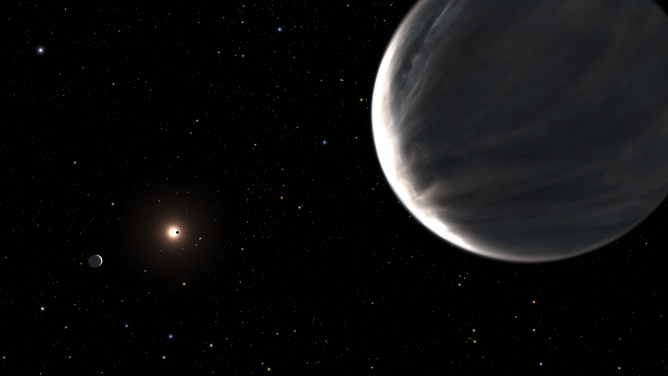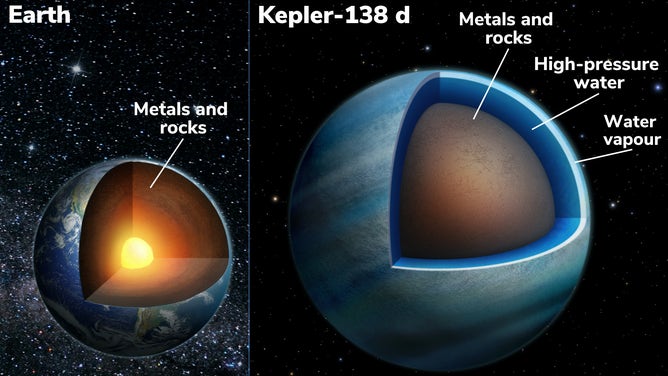Steamy science: Astronomers find 2 likely 'water world' exoplanets
The planets are part of a planetary system known as Kepler-138, which is about 218 light-years from Earth in the Lyra constellation. However, they're too close to their star to have an atmosphere cooler than the boiling point of water.

In this illustration super-Earth Kepler-138 d is in the foreground. To the left, the planet Kepler-138 c, and in the background the planet Kepler 138 b, seen in silhouette transiting its central star.
(NASA, ESA, and Leah Hustak (STScI) / NASA)
MONTREAL – A team of astronomy researchers in Montreal announced Thursday that two previously discovered exoplanets hundreds of light years away likely are primarily made of water.
However, these planets aren't likely covered in oceans like some Kevin Costner 90s flick, they're instead likely covered in an atmosphere of steam, the researchers believe.
The planets are part of a planetary system known as Kelper-138, which is about 218 light-years from Earth in the Lyra constellation. The planets were studied using the Hubble and retired Spitzer space telescopes by the team at the Trottier Institute for Research on Exoplanets at the University of Montreal.
The two potentially watery exoplanets, known as Kepler-138 c and d, and a third smaller planet were previously discovered by the Kepler Space Telescope in 2014, though the new study found evidence of a fourth exoplanet, researchers said. Both "c" and "d" are about 20% larger than Earth. Researchers spent the next two years studying the exoplanets' atmospheres using Hubble and Spitzer and announced their findings in Nature Astronomy on Thursday.
‘Best evidence yet for water worlds’
The telescopes didn't directly spot water on the exoplanets; instead, researchers concluded that by comparing the size and mass of the planets, as much as half of the planets are likely made of materials that are lighter than rock but heavier than hydrogen or helium, and water is the most likely candidate to fit the criteria.
"It is the best evidence yet for water worlds," said Bjorn Benneke, study co-author and professor of astrophysics at the University of Montreal. "A type of planet that was theorized by astronomers to exist for a long time."
HOW TO WATCH FOX WEATHER ON TV
Unlike Earth and its vast oceans, these planets sit much closer to their star, meaning their surface is too hot for liquid water.
"The temperature in Kepler-138 d's atmosphere is likely above the boiling point of water," said study author Caroline Piaulet. "We expect a thick dense atmosphere made of steam on this planet."
Though under that steamy layer of the atmosphere could be liquid water at high pressures, scientists added.

This is an artist's illustration showing a cross-section of the Earth (left) and the exoplanet Kepler-138 d (right).
(Benoit Gougeon / University of Montreal / FOX Weather)
Scientists are eager to study another exoplanet in the system - known as Kepler-138 e – that does seem to be in the "habitable zone" where its distance from the star could allow for liquid water. However, this planet does not appear to transit in front of its star, robbing researchers of a good way to observe the exoplanet's atmosphere.
The announced discovery comes nearly four months after the university announced the discovery of another exoplanet that could be primarily water. The planet, dubbed TOI-1452 b, is about 70% larger than Earth and is orbiting a red dwarf star some 100 light-years away in the constellation Draco.
NEWLY DISCOVERED ‘SUPER-EARTH' EXOPLANET COULD BE ‘WATER WORLD’
Researchers said they will continue to scour the heavens for evidence of more exoplanets.
"As our instruments and techniques become sensitive enough to find and study planets that are farther from their stars, we might start finding a lot more of these water worlds," Benneke said.